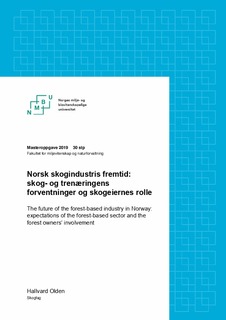| dc.contributor.advisor | Heltorp, Kaja | |
| dc.contributor.advisor | Nyrud, Anders Qvale | |
| dc.contributor.author | Olden, Hallvard | |
| dc.contributor.editor | Olden, Hallvard | |
| dc.coverage.spatial | Norway | nb_NO |
| dc.date.accessioned | 2019-06-19T11:36:09Z | |
| dc.date.available | 2019-06-19T11:36:09Z | |
| dc.date.issued | 2019 | |
| dc.identifier.uri | http://hdl.handle.net/11250/2601379 | |
| dc.description.abstract | Studiens målsetting var å kartlegge i) om det finnes forskjeller i hvordan representanter for de ulike verdikjedeleddene i skog- og trenæringen tolker utviklingsmulighetene for skogindustrien, og ii) hvordan disse representantene mener skogeierne skal involvere seg i ny industri. 23 semistrukturerte intervjuer med beslutningstakere i skog- og trenæringen utgjorde datagrunnlaget for studien. Intervjuene ble transkribert, og analysert som tekst.
Resultatene viste at deltakerne hadde relativt lik oppfatning av skogindustriens utvikling de siste fem årene. I grove trekk var deltakerne også enige om hvordan utviklingen i skogindustrien vil være de kommende årene. Det var imidlertid delte meninger til hvorvidt produksjon av biodrivstoff har en fremtid i Norge. Majoriteten av deltakerne var skeptiske eller negative til slik produksjon. Dette skyldes i stor grad at deltakerne mente slik produksjon gir for lav verdiskaping i forhold til råvarens potensial og at de var skeptiske til om det i fremtiden vil komme rammebetingelser som legger til rette for lønnsom produksjon.
For å skape utvikling må politikken bidra med langsiktige, stabile og gode rammebetingelser for industri, og økonomisk risikoavlastning til utviklingsprosjekter. Flere deltakere mente at man i skog- og trenæringen til dels er splittet og splittelsen er til hinder for utvikling. Næringen må selv finne løsninger som løser splittelsen og legger til rette for samarbeid.
Majoriteten av deltakerne var negative eller forutsettende til skogeierne som eiere av skogindustrien og det stilte spørsmål ved om skogeierne har nok kompetanse og kapital til å bidra til utvikling. De mente at skogeierne kan bidra til utvikling på andre måter, for eksempel ved å øke aktiviteten i skogen og ved å tilby langsiktige leveransekontrakter til industrien.
Egenskapene til den optimale eieren av skogindustri er ifølge deltakerne langsiktighet, kompetanse og kapitale muskler. Det er utfordrende å peke på en potensiell enkelteier som innehar alle disse egenskapene og det er derfor rimelig å anta at en kombinasjon av forskjellige eiertyper i samme industriselskap vil være hensiktsmessig. | nb_NO |
| dc.description.abstract | The aim of this study was to survey i) whether there are differences in how the representatives for the joints in the value chain in the forest-based sector interpret the development opportunities for the forest-based industry, and ii) how the sector believes the forest owners should be involved in new industry. 23 semi-structured interviews with leaders in the forest- and tree sector constituted the data basis for the study. The interviews were transcribed, and analyzed as text.
The results showed that the participants had a relatively similar view of the forest-based industry's development over the past five years. In rough terms, the participants also agreed on how the development in the forest-based industry will be in the coming years. The participants had different opinions on whether the production of biofuels has a future in Norway. The majority were skeptical or negative to such production within the country. This was largely due to skepticism towards political terms and conditions, witch they doubted would facilitate profitable production in the future. The participants also thought that such production is too of economic exploitation in relation to the raw material's potential.
To create development, policy must contribute to long-term, stable terms and conditions for forest-based industry, and financial risk-reduction for development projects. Several participants assessed that there is a lack of cooperation in the forest-based sector and that this is an obstacle to development. According to these participants, the sector must find solutions to resolve this this issue and facilitate for cooperation across the value chain.
The majority of the participants were negative or had reservations concerning forest owners as owners of the forest-based industry. The participants frequently questioned whether the forest owners had sufficient competence and capital to contribute to development. Instead, many thought forest owners could contribute to development in other ways, for example by increasing activity in the forest and by providing long-term supply contracts to the industry.
The characteristics of the optimal owner of the forest-based industry are, according to the participants, long-term, competence and can provide capital if necessary. It is challenging to point to potential individuals who holds all these qualities. It is therefore reasonable to assume that a combination of different owner types in the same industrial company would be beneficial. | nb_NO |
| dc.language.iso | nob | nb_NO |
| dc.publisher | Norwegian University of Life Sciences, Ås | nb_NO |
| dc.rights | Attribution-NonCommercial-NoDerivatives 4.0 Internasjonal | * |
| dc.rights.uri | http://creativecommons.org/licenses/by-nc-nd/4.0/deed.no | * |
| dc.subject | Skogindustri | nb_NO |
| dc.subject | Skogeiere | nb_NO |
| dc.subject | Forest-based sector | nb_NO |
| dc.subject | Forest industry | nb_NO |
| dc.subject | Biodrivstoff | nb_NO |
| dc.subject | Industry development | nb_NO |
| dc.subject | Biofuel | nb_NO |
| dc.subject | Industriutvikling | nb_NO |
| dc.title | Norsk skogindustris fremtid : skog- og trenæringens forventninger og skogeiernes rolle | nb_NO |
| dc.title.alternative | The future of the forest-based industry in Norway : expectations of the forest-based sector and the forest owners’ involvement | nb_NO |
| dc.type | Master thesis | nb_NO |
| dc.subject.nsi | VDP::Landbruks- og Fiskerifag: 900::Landbruksfag: 910::Skogbruk: 915 | nb_NO |
| dc.source.pagenumber | 68 | nb_NO |
| dc.description.localcode | M-SF | nb_NO |

